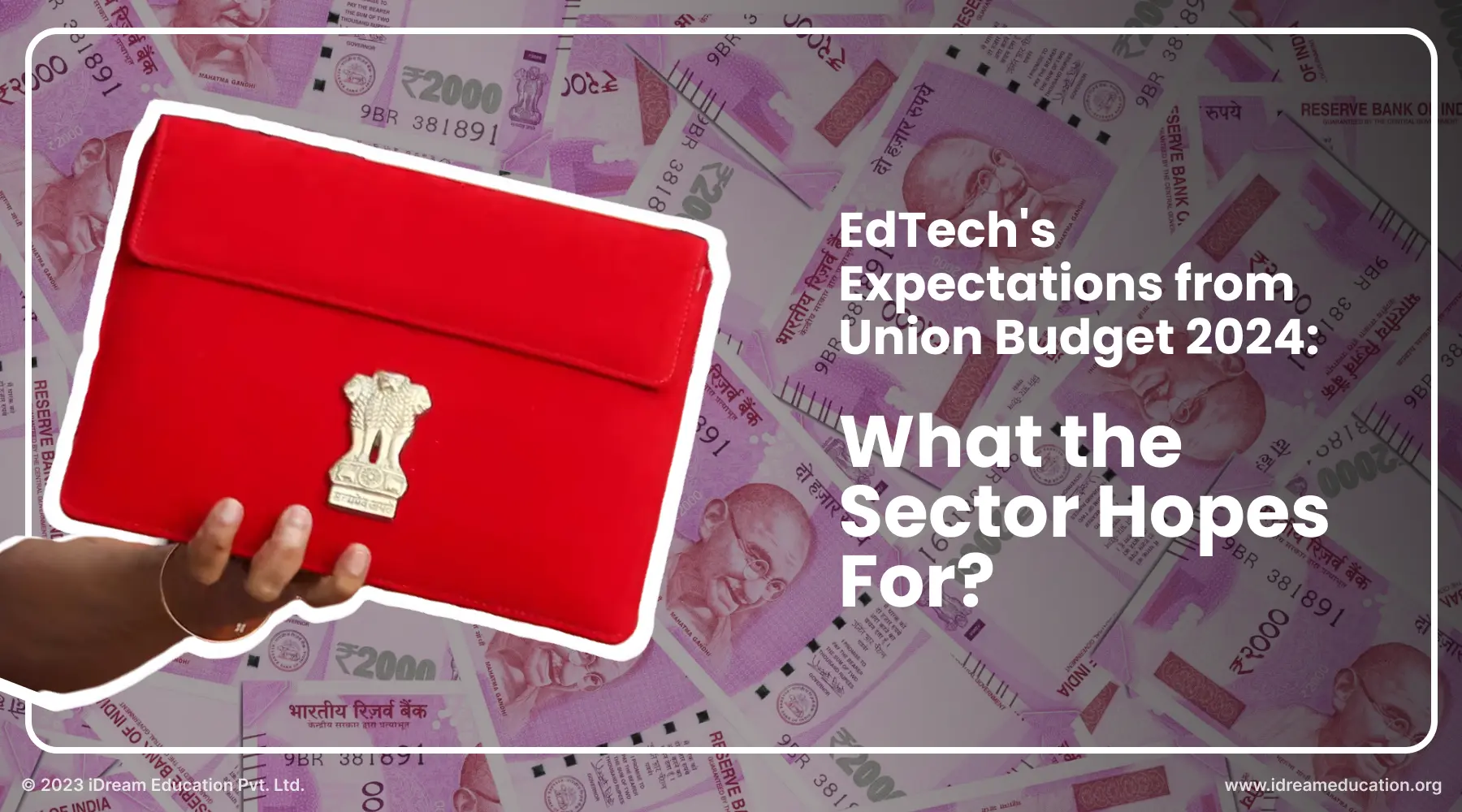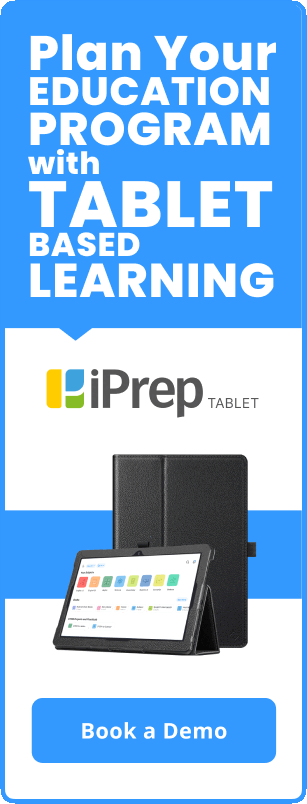Eradicating the digital divide in education with iPrep
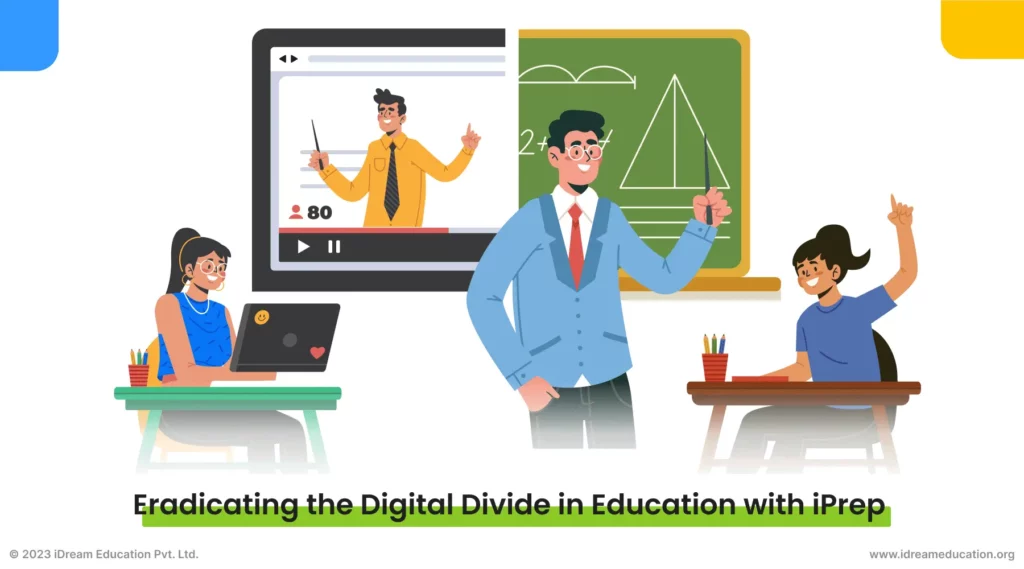
The significance of digital literacy and technology integration in education cannot be overstated in a rapidly evolving 21st century environment, where technology drives advancement and creativity. As we advance into the digital age, a significant obstacle, particularly concerning school students, remains the digital divide in education. The digital divide in education hampers the potential of those with limited access to contemporary technologies. In this context,
iPrep plays a pivotal role in dismantling barriers to educational equity. By providing accessible and inclusive resources, iPrep empowers learners, regardless of their background or circumstances. The platform’s innovative approach fosters a level playing field, ensuring that all students have equal opportunities to thrive academically. Through personalized learning experiences, iPrep contributes to creating a more equitable educational landscape, bridging gaps, and promoting fairness in access to quality education.
The digital divide in education in India presents a multifaceted challenge, manifesting in various forms due to geographical, infrastructural, and socioeconomic differences. While mobile connectivity is experiencing rapid expansion, it is not distributed evenly. Notably, girls are lagging behind, with studies revealing that girls are approximately 15% less likely to own a mobile phone compared to boys. This gender-based disparity in technology access adds a layer of complexity to the overall issue.
In educational environments across different regions of the country, students from underserved communities face a significant disadvantage in this digital divide. The unequal access to digital resources prevents them from tapping into the full spectrum of knowledge and opportunities available in the digital domain. Addressing these disparities is crucial for creating a more inclusive and equitable educational landscape in India.
Understanding the Digital Divide
The discrepancies in students’ access to and use of information and communication technology (ICT) are collectively referred to as the digital divide in education. A digital divide hinders equal learning opportunities, creating disparities between the digitally empowered and disadvantaged.
Socioeconomic disparities are one of the main causes of the digital divide in education. Many economically disadvantaged students do not have access to computers, tablets, or a reliable internet connection. Limited digital access creates an educational gap, depriving individuals of online learning benefits, collaborative tools, and a rich resource library, resulting in divergent educational outcomes.
Geographical differences make this gap even more obvious, as rural and isolated regions frequently experience infrastructure problems that make it difficult to incorporate technology into the teaching and learning process.
Understanding and addressing the digital divide in education is essential for fostering a truly inclusive educational environment. It guarantees every student has the chance to succeed in the digital age, as education increasingly depends on digital mediums for content delivery, collaboration, and skill development.
The Significance of Digital Literacy in Addressing the Digital Divide
In our contemporary era, marked by the pervasive influence of technology in various facets of life, the digital divide has emerged as a critical societal challenge. This gap, characterized by disparities in access to and proficiency with digital technologies, has the potential to perpetuate existing inequalities. Digital literacy, defined as the ability to use, understand, and critically evaluate digital information and technology, is identified as a key factor that could bridge this divide.
Digital literacy is a prerequisite for meaningful participation in the digital age, enabling individuals to harness the benefits of technology for accessing information, effective communication, and participation in the global economy.
Conversely, the digital divide can impede the widespread adoption of digital literacy initiatives. Access to technology is crucial for individuals to enhance their digital literacy skills. Without equitable access to digital resources, marginalized communities may find it challenging to navigate the digital landscape effectively.
Comprehensive strategies addressing the reciprocal relationship between digital literacy and the digital divide are essential. Bridging the divide requires providing technology access and fostering digital literacy, while efforts to enhance digital literacy should tackle structural and economic barriers contributing to the divide. Recognizing their intertwined nature is crucial for developing effective strategies, and promoting digital literacy alongside efforts to narrow the digital divide for a more inclusive and equitable digital future.
Now let’s look at the digital disparity in India in the next section.
Digital Disparity in India: Navigating the Urban-Rural Digital Divide
The digital divide in India, characterized by a significant gap in access to digital technologies, is most pronounced between urban and rural areas. According to a report by the National Statistical Office (NSO), in 2020 42% of homes in cities had internet access, while in rural India, only 15% were connected to the internet. Urban residents, with higher purchasing power, demonstrate greater digital literacy, facilitated by access to laptops, computers, smartphones, and tablets. In contrast, limited resources in rural areas, where schools and Anganwadis lack infrastructure for digital education, contribute to this disparity.
Economic constraints in rural regions exacerbate the gap, placing residents at a distinct disadvantage in digital literacy compared to their urban counterparts.
Since 2004-2005, government entities and corporate social responsibility (CSR) initiatives have actively worked to reduce this digital gap. Initiatives have included providing laptops, establishing computer labs, and distributing mobile devices.
While private schools adapted more easily, government schools faced challenges due to time constraints on teachers. These constraints arise from additional responsibilities, such as involvement in election campaigns, participation in polio vaccination camps, and engagement in various initiatives. These supplementary duties can lead to a lack of awareness about events in schools and may result in missing essential training sessions required for the effective utilization of devices.
Additionally, as per the India Inequality Report 2022: Digital Divide by Oxfam, 80 % of teachers experienced difficulties in teaching online and 20% of teachers reported that they did not receive adequate training in delivering education digitally. In fact, two out of every five teachers claimed not to have access to the devices needed for digital teaching; This situation highlights the need for a balanced approach to managing teachers’ responsibilities, ensuring they stay informed and adequately trained to enhance their effectiveness in utilizing educational technology.
The COVID-19 pandemic significantly altered the landscape, compelling schools to adopt digital methods for remote learning. Efforts were made to bridge the gap by distributing laptops and tablets, reaching 70-80% of students but leaving a 20% gap and resulting in notable learning disparities.
While progress has been made, challenges persist, even during the pandemic when online education could have been more widely embraced. The current scenario is an improvement from the past, but a substantial journey remains. The outbreak underscored the need for digital inclusivity in education, requiring collaborative efforts from government bodies, educational NGOs, and CSR initiatives like CSR Wings, which currently prioritizes fundamental needs such as clothing, shelter, and food. Bridging the remaining gaps demands ongoing commitment to create a more digitally inclusive educational landscape in India.
Across India, only one in ten households has a computer, laptop, or tablet. Online education remained a challenge for many, as access to the internet through any kind of device was found to be far better in urban India at 44% than in rural areas at 17%. The urban-rural disparity in the digital divide is evident from the extent of internet penetration in the country, as per the NSO, where there is less than 20% internet penetration even in states with software hubs, such as Karnataka and Tamil Nadu.
Now let us look at some of the government initiatives that help to bridge the gap for the digital divide in education.
Govt initiatives to Eliminate the Digital divide in education
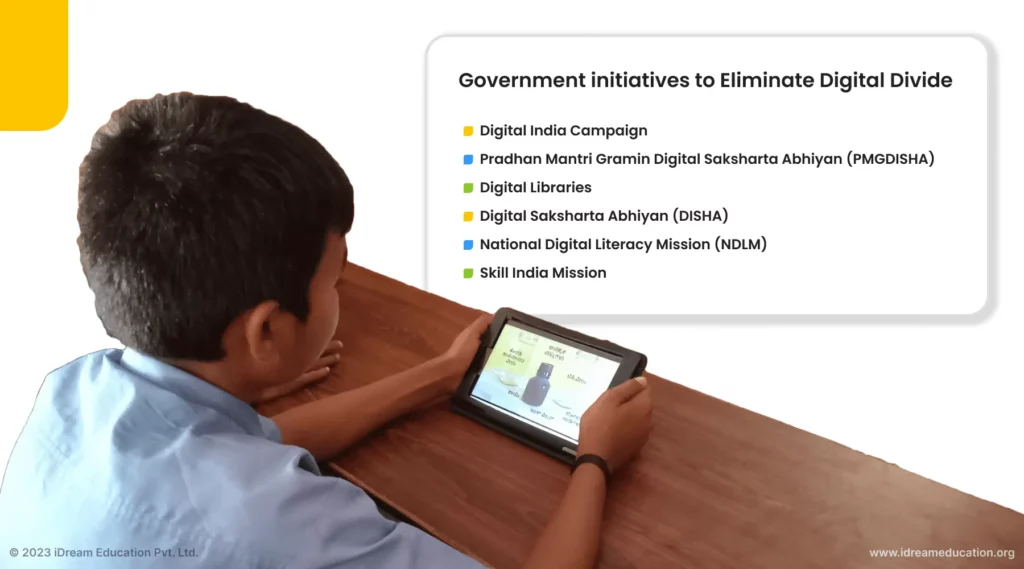
India’s digital literacy initiatives aim to empower the masses by promoting technology adoption and increasing digital literacy nationwide. The government has taken several steps to bridge the digital divide in education and ensure that every citizen has access to digital resources and the skills required to utilize them effectively. Let’s explore some of the key digital literacy initiatives in India:
Digital India Campaign
The Digital India campaign, which Prime Minister Narendra Modi unveiled on July 1, 2015, is a flagship project to make India a society empowered by technology. It centres on three main elements: the development of digital infrastructure, the provision of digital services, and digital literacy. The initiative aims to increase digital literacy among individuals, encourage the use of digital platforms for service delivery, and provide high-speed internet connectivity in rural areas.
Pradhan Mantri Gramin Digital Saksharta Abhiyan (PMGDISHA)
PMGDISHA, a noteworthy project under the Digital India movement, was introduced in 2017. It seeks to make six crore rural households digitally literate by giving them access to digital gadgets, internet connectivity, and digital literacy training. The initiative provides free seminars on digital literacy that cover a range of topics, including utilizing cell phones, gaining access to e-services, and making purchases online.
Digital Libraries
To facilitate access to digital resources and encourage digital reading, the government has set up digital libraries across the nation. These libraries provide e-books, e-journals, and other instructional materials to encourage independent learning and improve digital literacy.
Digital Saksharta Abhiyan (DISHA)
The Ministry of Electronics and Information Technology launched DISHA as a program to improve digital literacy among government officials and non-IT workers. It offers training courses to advance one’s knowledge and proficiency in digital fields such as cybersecurity, digital payments, and e-governance.
National Digital Literacy Mission (NDLM)
The goal of the Ministry of Electronics and Information Technology’s NDLM program is to provide at least one member of every Indian family with digital literacy training. The program provides training modules on e-governance services, internet usage, online safety, and fundamental computer operations. Its main goal is to employ digital literacy to empower the underprivileged segments of society.
Skill India Mission
The Skill India initiative recognizes the significance of digital skills in the contemporary workforce, even though its focus is not exclusively on digital literacy. It provides a range of programs for skill development, including instruction in digital literacy, giving people the tools they need to succeed in the digital economy.
Awareness Campaigns
To encourage widespread digital literacy, the government, businesses, and non-governmental groups run awareness programs. The goal of these efforts is to increase public knowledge of digital technologies, their advantages, and practical applications. They also cover issues with cybersecurity, privacy, and internet safety.
These digital literacy initiatives are instrumental in bridging the digital divide in education and empowering individuals across all stages of society. By providing access to digital resources, imparting digital skills, and promoting technology adoption, India is paving the way for a digitally empowered and inclusive society. These initiatives not only enable individuals to access information and services more efficiently but also open up new avenues for employment, entrepreneurship, and personal growth finally resulting in closing the gap between digital divide in education.
How can iPrep be a driver for eradicating the digital divide among students?
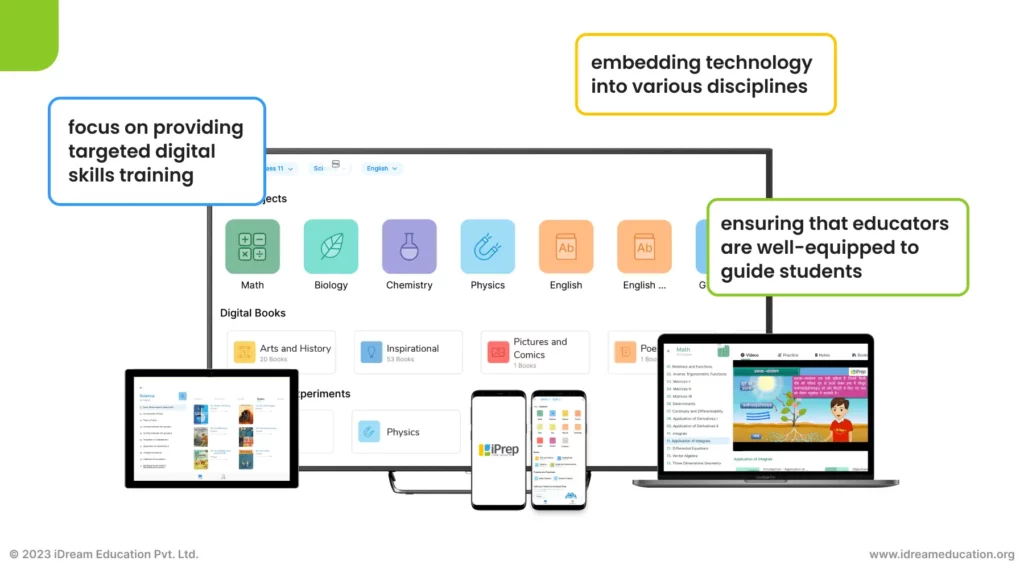
iPrep emerges as a powerful catalyst in narrowing the digital divide within education. Its comprehensive and affordable solution is dedicated to advancing digital literacy among students. The platform achieves this by ensuring a user-friendly interface for diverse learners, coupled with interactive and engaging content that elevates the learning experience. Moreover, iPrep champions personalized learning, tailoring educational content to individual needs and fostering inclusivity. These features collectively contribute to eradicating the digital divide, equipping all students with the tools necessary to thrive in an increasingly digital educational landscape.
To effectively address the digital divide in education, iPrep can initiate measures ensuring equitable access to digital devices and reliable internet connectivity for all students. This step is pivotal in bridging the gap between those with and without access to technology. Additionally, iDream solutions can focus on providing targeted digital skills training to students who may lack prior exposure to digital tools.
By seamlessly integrating technology into various disciplines, iPrep facilitates the organic development of students’ digital competencies as part of their overall education. This approach not only enhances their digital skills but also makes these skills integral to their academic success.
Crucially, iPrep prioritises teacher training to ensure educators are well-equipped to guide students in the digital realm. Teachers act as facilitators, guiding students through digital resources and cultivating a supportive learning environment.
In essence, iPrep stands as a driving force in tackling the digital divide in education by providing equal access to technology, offering targeted digital skills training, integrating technology into the curriculum, and empowering educators to effectively guide students in the digital age. Through these measures, iPrep contributes to creating a more equitable educational landscape, where all students have the opportunity to develop essential digital literacy skills.
Let’s conclude
In conclusion, the persistent challenge of the digital divide in education demands innovative solutions and collective efforts. Navigating the 21st century, we cannot overstate the transformative potential of digital literacy and access to technology. The disparities in students’ access to digital resources underscore the urgent need for initiatives like iPrep to bridge the gap. iPrep’s comprehensive approach, encompassing equitable access to devices, targeted skills training, and curriculum integration, positions it as a powerful driver in eradicating the digital divide in education.



